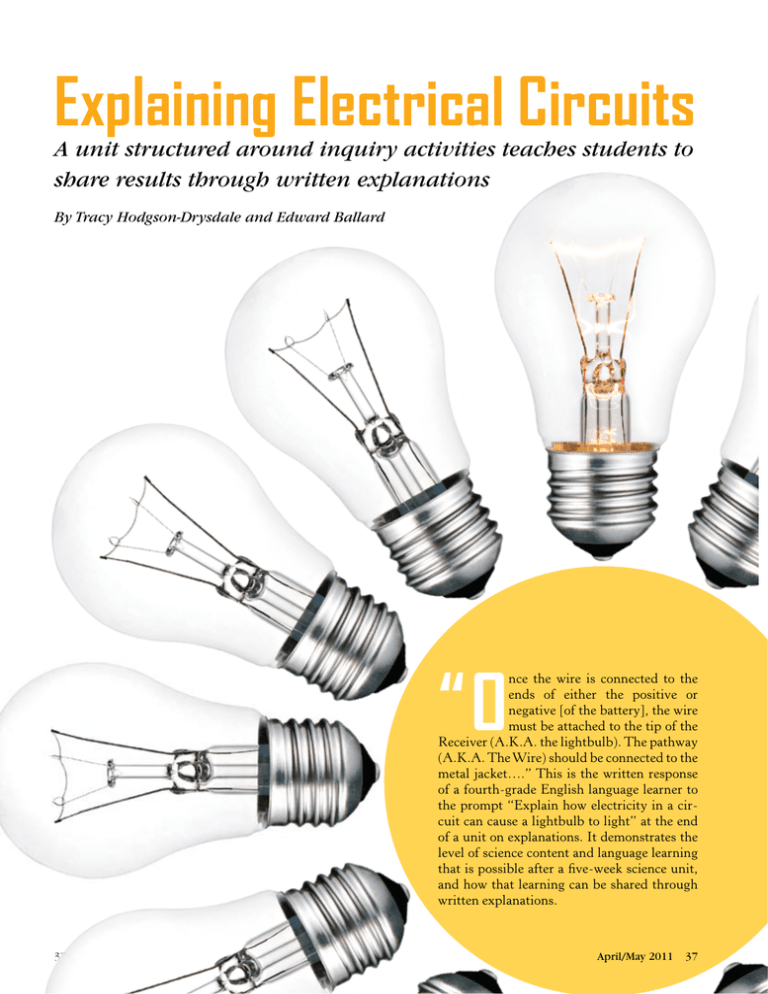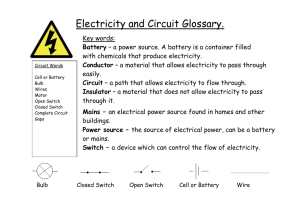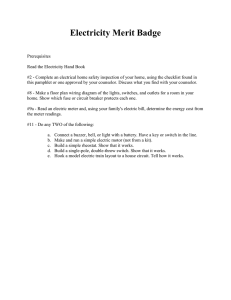Explaining Electrical Circuits
advertisement

Explaining Electrical Circuits A unit structured around inquiry activities teaches students to share results through written explanations By Tracy Hodgson-Drysdale and Edward Ballard “O nce the wire is connected to the ends of either the positive or negative [of the battery], the wire must be attached to the tip of the Receiver (A.K.A. the lightbulb). The pathway (A.K.A. The Wire) should be connected to the metal jacket….” This is the written response of a fourth-grade English language learner to the prompt “Explain how electricity in a circuit can cause a lightbulb to light” at the end of a unit on explanations. It demonstrates the level of science content and language learning that is possible after a five-week science unit, and how that learning can be shared through written explanations. 37 Science and Children April/May 2011 37 Science is more than learning a collection of facts. In the classroom, it is about creating a deeper level of understanding of the world and providing students with the tools to share that knowledge. We can share knowledge orally or in writing, in a variety of genres such as reports, arguments, and explanations. As a researcher working on writing in elementary science and a science teacher, we teamed up for a unit on explanation designed to teach fourth-grade students to demonstrate their learning of scientific concepts and language through written explanations of scientific phenomena. It is important to note that this unit was designed to be inclusive of all learners and that bilingual learners worked alongside their peers to accomplish all tasks, in addition to learning the English language. Figure 1. Sample t-table. Familiarity In the upper elementary grades, explanations provide students with an appropriate means for sharing the results of research into various phenomena. Two crucial aspects of sharing findings are (a) the inclusion of scientific concepts and (b) appropriate technical language. An important part of helping students deepen their understanding of scientific phenomena is giving them regular opportunities to become familiar with the language of science by introducing technical language through teacher read-alouds, discussions, and inquiry activities. Learning the language of science is essential for all children and is crucial when sharing results. Children need to learn new technical language in relation to new science content, and they need to know how to use this language to understand and explain the content. Another way to help students deepen this understanding is to provide regular opportunities to explain phenomena orally in class discussions and through a combination of collaborative and independent writing. Sharing the results of inquiry in science is an essential part of learning for all students, and sharing through writing enhances that learning (Newell 2006; Wollman-Bonilla 2000). Planning the Unit Our unit was designed to help fourth graders explain (in writing) scientific concepts they learned through inquiry activities and explicit teaching. We believe this helps them deepen their understandings of the content. First, the students needed to be taught the “genre of explanation” and the language choices available to them (Derewianka 1990; Halliday and Martin 1993). This means knowing the structure of explanation, in which each text begins with a clear statement of the phenomenon itself (e.g., Electricity flowing in a 38 Science and Children circuit can cause a lightbulb to light.), followed by a sequenced explanation of how or why it occurs (e.g., A circuit is created when a battery is connected to a lightbulb using a minimum of two wires. The wires form pathways to conduct the electricity. One wire connects either the positive or negative end of the battery to the metal jacket of the bulb, the other connects the tip of the bulb back to the opposite end of the battery. When the wires are connected, the circuit is complete, which will cause the bulb to light up.). Explanation also requires certain elements of language to be effective. For example, explanations often require technical language (e.g., electricity, circuit, connector, insulator) and content-specific action verbs (flow, light, connect) to aptly describe the phenomenon. Verbs are usually in the present tense to suggest the timelessness of the information being conveyed. Participants—who or what is taking part—in explanations are generalized (e.g., “electricity,” “a battery,” “a wire”) as opposed to specific participants (e.g., “the electricity,” “the battery,” “the wire”) because the purpose of the genre is to explain broader scientific phenomena and not how to create one particular circuit. For a detailed explanation of the most common genres, including explanation, see Derewianka (1990). Explaining Electrical Circuits Figure 2. Sample word bank. circuit is created by connecting a D-cell battery to a lightbulb using two wires,” where “a circuit,” “a Dcell battery,” and “two wires” are general so that they apply to any set of batteries, lightbulbs, and wires. If they weren’t generalized then it would read “The circuit is created by connecting the D-cell battery to the lightbulb using the two wires” and it would be referring to a specific circuit as opposed to explaining how the circuit works. Teaching Language Implementing the Unit The electricity unit was structured around a variety of inquiry activities designed to help students learn about electricity. Each week the science teacher introduced a new electricity concept and the related technical language to students. For example, during week three students learned about the flow of electricity and the terms conductors and insulators. Students were given a D-cell battery, a lightbulb and stand, three wires, and a variety of other materials. They created an open circuit into which each different material could be placed to see which ones would conduct electricity, complete the circuit, and light the bulb. Students reported their findings in a t-table in their notebooks (Figure 1). Teaching Explanation Teaching explanation was accomplished in a variety of ways throughout the electricity unit. The science teacher modeled explanations orally and read a variety of mentor texts or examples of the genre to students (see Print Resources). He also explained how questions relating to the flow of electricity were not asking students to write a procedure (which they were familiar with from third grade), but were instead asking them to explain how or why the phenomenon worked a certain way (Derewianka 1990; see Internet Resources). Another method of teaching about explanation was collaboration, in which the teacher and students created both oral and written explanations of electrical phenomena (e.g., how electricity flows in a circuit, or why some objects are conductors and some are insulators) after an inquiry activity. The teacher also modeled and explained the use of verbs (present tense) and generalized participants in the explanations. For example, “A Learning the language of science took place throughout the unit by identifying new technical terms, reading books aloud to the class, creating diagrams of circuits, and daily group discussions. New technical language was introduced by the teacher each class and previous terms were revisited during discussions and inquiry activities. The teacher also created word banks which included technical terms, a simple definition, and a labeled diagram of the concept whenever it was relevant (Figure 2). The word banks were posted in the classroom for students to use during discussions, activities, and writing. Students also kept a glossary of the terms in their science notebooks. The teacher read aloud a variety of books, such as Angela Royston’s (2003) Conductors and Insulators, which describes how electricity is used, how to create an electric circuit, and the phenomenon of the flow of electricity (see Print Resources). The teacher engaged students in daily group discussions where he helped them learn to use technical language to ask questions, increase understanding, and create collaborative oral and written explanations of concepts. On some occasions he used chart paper to create diagrams of circuits, and on others he asked students to play the role of teacher and draw a circuit diagram for the class. Then students would explain whether the circuit was complete and why. They also discussed the concept of simple circuits in relation to inquiry activities conducted during lessons. Assessment We asked students to write uncoached explanations about the flow of electricity at the beginning and the end of the unit using the prompt “Explain how electricity in a circuit can cause a lightbulb to light.” We analyzed the initial student explanations using a rubric (Figure 3, p. 40) to see what students already knew about creating explanations and the flow of electricity and which aspects of explanation and content would need to be taught. We also used the initial student writing to select two specific language objectives: technical language and the use of action verbs. At the conclusion of the unit we April/May 2011 39 analyzed the students’ final written explanations using the same rubric. What Students Learned Students shared their understanding of the electricity concepts and language skills at the end of the unit through written explanations. These explanations showed that students had learned many things about the genre of explanation, the content, and the language of the unit. The student writing showed better organization of ideas, partial to thorough explanations of how electricity flows through a circuit, and increased use of technical vocabulary. Students still had difficulty writing the identifying statement of the phenomenon and using action verbs specific to the phenomenon. For example, in Figure 4 the student begins “A circuit can make a lightbulb turn on,” which would be a more complete initial statement if it were phrased as “Elec- tricity flowing through a complete circuit can make a lightbulb turn on,” or “A circuit can make a lightbulb turn on when it is complete and allows for the flow of electricity.” We concluded that students needed more modeling and support in these areas, which could occur by having them continue to write explanations of phenomena throughout the school year. When sharing their understanding, some students focused on certain parts of the phenomenon. For example, one student focused on details about the bulb itself “when the [they] attached one wire to the D-cell battery to the tipe [tip] of an lightbulb…with another wire attached to the D-cell battery to the metal jacket of a lightbulb.” Another student focused on the overall circuit concluding, “If there’s a gap the lightbulb won’t light up.” These examples show increased knowledge of the phenomenon of the flow of electricity and also an increased ability to use the language of science in writing explanations. Figure 3. Explanation rubric for fourth grade. Structure of genre Statement of phenomenon Explanation of how electricity flows through a circuit Science content Recognize that electricity in circuits requires a complete loop through which an electrical current can pass, and that electricity can produce light, heat, and sound Language Technical language Action Verbs 40 Science and Children Well-developed Adequate development Limited development Identifying statement is complete and stated clearly Sequencing is logical and ideas are organized to effectively address the question of how electricity flows Identifying statement is partially complete or is unclear Sequencing is somewhat organized, ideas are grouped appropriately some of the time Identifying statement is unclear or not included Thorough explanation of how electricity flows in a complete circuit, and reference to the production of light, heat, or sound Partial explanation of how electricity flows in a complete circuit, or some reference to the production of light, heat, or sound Minimal explanation of how electricity flows in a complete circuit, or reference to the production of light, heat, or sound Strong use of technical terms increases overall text cohesion Verbs describe specific actions related to the phenomenon being explained and contribute to overall clarity of text Some use of technical terms, sometimes increases text cohesion Some verbs are related to the phenomenon and contribute to meaning Minimal use of technical terms, does not contribute to overall text cohesion Verbs are too general to contribute to overall meaning Sequencing is absent, ideas are included in seemingly random order Explaining Electrical Circuits Figure 4. Final uncoached explanation. Tracy Hodgson-Drysdale (drysdalt@bc.edu) is a third year doctoral student in Curriculum and Instruction at Boston College in Chestnut Hill, Massachusetts. Edward Ballard was a former science specialist and is now a third-grade teacher at Russell Elementary School in Dorchester, Massachusetts. References Derewianka, B. 1990. Exploring how texts work. Rozelle, NSW: Primary English Teaching Association. Halliday, M.A.K., and J.R. Martin. 1993. Writing science: Literacy and discursive power. Pittsburgh, PA: University of Pittsburgh Press. Newell, G.E. 2006. Writing to learn. In Handbook of writing research, eds. C.A. MacArthur, S. Graham, and J. Fitzgerald, 235–247. New York: Guilford. Wollman-Bonilla, J.E. 2000. Teaching science writing to first graders: Genre learning and recontextualization. Research in the teaching of English 35 (1): 35–65. Print Resources To further extend the sharing of their knowledge, students could be encouraged to write explanations for different audiences, such as other students in the school or their parents. It is important to note that changing the audience changes the way students write their explanation—using simpler sentence structures, simplifying some of the scientific vocabulary for younger audiences, or including extra background information about the phenomenon itself and clarification of scientific terms for audiences outside of school. We concluded that such extended sharing would make the writing more authentic for students and would further reinforce the concepts of the unit. What We Learned We learned that teaching students to write in genres commonly used in science, such as explanation, helped them learn content and language more deeply. This knowledge has led us to investigate teaching explanation with other topics and also teaching other written genres in science in the same way, through modeling by reading and deconstructing mentor texts, writing as a class in the focus genre, and gradually preparing students to write independently. n Atwater, M., P. Baptiste, L. Daniel, J. Hackett, R. Moyer, C. Takemoto, and N. Wilson. 1995. Electrical energy. New York: MacMillan/McGraw-Hill. Full Option Science System (FOSS) Science Stories. 2003. Magnetism and electricity. Berkley, CA: Delta Education. Mullick, R. 2007. Electricity at play: Using electricity. Washington, DC: National Geographic Society. Royston, A. 2003. Conductors and insulators. Portsmouth, NH: Heinemann Educational Books. Internet Resource Writing Fun by Jenny Eather www.writingfun.com/writingfun2010.html Connecting to the Standards This article relates to the following National Science Education Standards (NRC 1996): Content Standards Grades K–4 Standard A: Science as Inquiry • Abilities necessary to do science inquiry • Understanding about science inquiry Standard B: Physical Science • Light, heat, electricity, and magnetism National Research Council (NRC). 1996. National science education standards. Washington, DC: National Academies Press. April/May 2011 41 Copyright of Science & Children is the property of National Science Teachers Association and its content may not be copied or emailed to multiple sites or posted to a listserv without the copyright holder's express written permission. However, users may print, download, or email articles for individual use.




